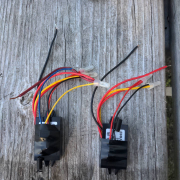That Moment When You Realize There Was Never a Wire!
So far, this has to be the most interesting job we’ve ever done. The story has so many angles, it’s hard to decide where to begin. Because it’s sure to be a “too long didn’t read”, I’ll break it down into sections.
The Customer Concern
A very nice fellow staying across the campground from us at Buccaneer State Park in Waveland, MS, stopped by one day to ask us to have a look at his front furnace, which would not fire up. He had bought his 2006 Fleetwood motorhome from an estate and knew nothing of its past. The front furnace not firing might be related to something a little odd in plain sight.
The front air conditioner installed at the factory was a Coleman Mach configured as Zone 1 with a Zone 2 in the bedroom. It had been changed out for a Dometic at some point and a second thermostat installed for it. The thermostat was aware of the furnace, but the furnace would not activate. The owner believed the installation of the Dometic was in some way incomplete or faulty and wanted us to check it out.
The Purple Monkey
A “Purple Monkey” in the NRVTA world means basically a wild goose chase. We checked out the Dometic and everything had been configured properly for it to control the front furnace. However, the relay in the AC control box that should be connected to a wiring harness to send the 12VDC activation signal to the furnace was not connected to anything at all. The Coleman harness was still there, so it looked like all that needed happen was hooking up the usual wire and we’d be all set.
One should NEVER just apply voltage to a wire in an RV without verifying the wire isn’t shorted somewhere and actually terminates where you think it does. The good news: the wire wasn’t shorted to ground and had no voltage on it. The bad news: it also didn’t terminate anywhere near the furnace. A tone generator was able to “hear” the wire to somewhere near the edge of the roof, but then it just disappeared. We decided to trace it from the furnace up when we found the REAL problem.
Are You Serious?!
The furnace connection on this Atwood is a 6 pole plug which SHOULD have four wires on it: all 12VDC, positive house power, chassis ground (aka negative), power out to the AC control box, and a line in from AC control box. The wire coming back from the AC control box, which normally activates the furnace with 12VDC, was MISSING. We pealed back the vibration shielding on the umbilical to the slide out where the furnace was mounted and it wasn’t there either! Apparently, the factory forgot to include the wire in the lower section of the harness altogether.
We went outside and scoped the exhaust port, and sure enough, this furnace had NEVER been hot. It was basically brand new at 15 years old.
No Way It’s Worth It
Running a new wire inside a fully built coach is a nightmare. If it can be done at all, it takes a lot of time (hence expense) to do it. This job would’ve definitely been on the long side because it’s pretty much three separate jobs to get the wire from the roof to the wall, from the top of the wall to the bottom of the wall, and then out into the slide out. Just making it right would’ve cost hundreds (if not thousands). It was time to think outside the box.
What Are My Options?
- Installing a third thermostat which only operated the furnace would’ve also taken a lot of time and the placement of that thermostat could not have been very effective in the floor plan of the coach.
- A manual On switch that simply fired up the furnace by giving it the 12VDC signal is not necessarily a safe way to solve the problem. If the furnace’s thermal cutoff failed in the on position, it would definitely be a fire hazard.
- Just don’t use it? The whole reason it became a concern is the owner planned more cool weather camping this year. Electric heat is good, but nothing compared to the power of propane.
- Do something WAY outside the box. << This one!
Scotty, Beam Me a Furnace Activation Signal
I’d been cruising Facebook a few days before and just happened to get offered an Amazon ad for a pair of chips that use a 433MHz encrypted radio signal to activate something via a relay. The transmitter side of it is basically the guts of a key fob for power door looks. The receive side just knows how to open a small digital relay. This was the perfect time to go mad scientist!
We paired the little chips with voltage regulators to bring the house 12VDC power down to a friendly and consistent 9VDC. This step might have been unnecessary because the chip claimed its maximum voltage was 12. We know the alternator on a motorhome produces 14VDC and if the owner ever installed LiFePO4 batteries, they need 14.4V to balance the cells. We thought it best to spend the extra ten bucks on some cheap insurance and use regulators.
The remote control chip was powered up by running house 12VDC into one side of the AC control box heater relay. The other side of that relay powered the regulator which powered the chip and activated the radio signal.
The regulator for the receiver control chip was connected near the furnace to 12VDC house power through a kill switch mounted on the outside of the cabinet the furnace is hiding under. One side of the relay was also connected to the same 12VDC source (which the chip was rated to handle). The other side of the relay was wired into the furnace connector finally providing that fourth missing wire.
PRESTO!
It seems after all that, the conclusion should be more exciting, but it simply worked. The total cost of the project was around $150 including parts and our time to find and test the setup, a figure that was well worth it to the owner and vastly less than any other route to a solution.
We really enjoyed this project because the nerd factor was 11 out of 10. There are a few takeaways in retrospect:
- Never assume anything.
- Do the proper diagnostics if you want to avoid the dreaded Purple Monkey. We would’ve looked like idiots if we’d just tried replacing the furnace control board. Who knows, maybe the change to the Dometic AC was also an attempt to make that furnace work.
- Don’t just think outside the box, understand there IS NO BOX!

